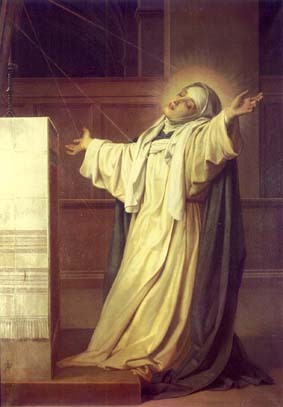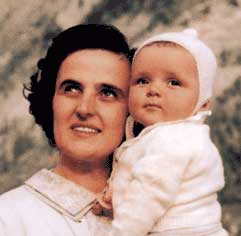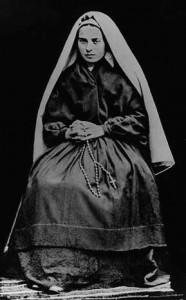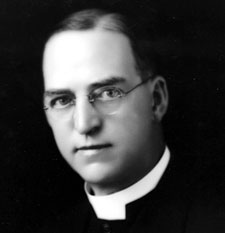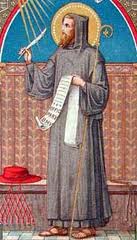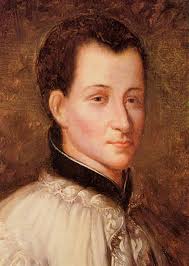Holy Mary
Holy Repentance
Tags: catherine of siena, catholic, catholic podcast, catholic prayer, cathollc spirituality, Holy Mary
This entry was posted on Sunday, April 29th, 2012 at 12:54 am
You can follow any responses to this entry through the RSS 2.0 feed.
Gianna Beretta Molla (1922-1962)
Gianna Beretta was born in Magenta (Milan) October 4, 1922. Already as a youth she willingly accepted the gift of faith and the clearly Christian education that she received from her excellent parents. As a result, she experienced life as a marvellous gift from God, had a strong faith in Providence and was convinced of the necessity and effectiveness of prayer.
She diligently dedicated herself to studies during the years of her secondary and university education, while, at the same time, applying her faith through generous apostolic service among the youth of Catholic Action and charitable work among the elderly and needy as a member of the St. Vincent de Paul Society. After earning degrees in Medicine and Surgery from the University of Pavia in 1949, she opened a medical clinic in Mesero (near Magenta) in 1950. She specialized in Pediatrics at the University of Milan in 1952 and there after gave special attention to mothers, babies, the elderly and poor.
While working in the field of medicine-which she considered a “mission†and practiced as such-she increased her generous service to Catholic Action, especially among the “very young†and, at the same time, expressed her joie de vivre and love of creation through skiing and mountaineering. Through her prayers and those of others, she reflected upon her vocation, which she also considered a gift from God. Having chosen the vocation of marriage, she embraced it with complete enthusiasm and wholly dedicated herself “to forming a truly Christian familyâ€.
She became engaged to Pietro Molla and was radiant with joy and happiness during the time of their engagement, for which she thanked and praised the Lord. They were married on September 24, 1955, in the Basilica of St. Martin in Magenta, and she became a happy wife. In November 1956, to her great joy, she became the mother of Pierluigi, in December 1957 of Mariolina; in July 1959 of Laura. With simplicity and equilibrium she harmonized the demands of mother, wife, doctor and her passion for life.
In September 1961 towards the end of the second month of pregnancy, she was touched by suffering and the mystery of pain; she had developed a fibroma in her uterus. Before the required surgical operation, and conscious of the risk that her continued pregnancy brought, she pleaded with the surgeon to save the life of the child she was carrying, and entrusted herself to prayer and Providence. The life was saved, for which she thanked the Lord. She spent the seven months remaining until the birth of the child in incomparable strength of spirit and unrelenting dedication to her tasks as mother and doctor. She worried that the baby in her womb might be born in pain, and she asked God to prevent that.
A few days before the child was due, although trusting as always in Providence, she was ready to give her life in order to save that of her child: “If you must decided between me and the child, do not hesitate: choose the child – I insist on it. Save himâ€. On the morning of April 21, 1962, Gianna Emanuela was born. Despite all efforts and treatments to save both of them, on the morning of April 28, amid unspeakable pain and after repeated exclamations of “Jesus, I love you. Jesus, I love you», the mother died. She was 39 years old. Her funeral was an occasion of profound grief, faith and prayer. The Servant of God lies in the cemetery of Mesero (4 km from Magenta).
“Conscious immolation», was the phrase used by Pope Paul VI to define the act of Blessed Gianna, remembering her at the Sunday Angelus of September 23, 1973, as: “A young mother from the diocese of Milan, who, to give life to her daughter, sacrificed her own, with conscious immolationâ€. The Holy Father in these words clearly refers to Christ on Calvary and in the Eucharist.
Gianna was beatified by Pope John Paul II on April 24, 1994, during the international Year of the Family.
Tags: catholic, Catholic Action, catholic podcast, catholic prayer, cathollc spirituality, Gianna Beretta, Gianna Beretta Molla, st. gianna beretta molla
This entry was posted on Saturday, April 28th, 2012 at 8:37 am
You can follow any responses to this entry through the RSS 2.0 feed.
Vatican City, 25 April 2012 (VIS) – If prayer and the Word of God do not nourish our spiritual life, we run the risk being
suffocated by the many cares and concerns of daily existence. Prayer makes us see reality with new eyes and helps us to find our way in the midst of adversity. These words were pronounced by Benedict XVI in his catechesis during this morning’s general audience, held in St. Peter’s Square in the presence of more than 20,000 faithful.
The Pope explained how prayer encouraged the early Church, though beset by difficulties, and how it can help man to live a better life today. “Ever since the beginning of her journey the Church has had to face unexpected situations, new questions and emergencies, to which she has sought to respond in the light of the faith, allowing herself to be guided by the Holy Spirit”, he said.
This was already evident at the time of the Apostles. In the Acts, Luke the Evangelist recounts “a serious problem which the first Christian community in Jerusalem had to face and resolve, … concerning the pastoral care of charity towards the isolated and the needy. It was not an unimportant issue and risked creating divisions within the Church. … What stands out is that, at that moment of pastoral emergency, the Apostles made a distinction. Their primary duty was to announce the Word of God according to the Lord’s mandate, but they considered as equally serious the task of … making loving provision for their brothers and sisters in situations of need, in order to respond to Jesus’ command: love one another as I have loved you”.
The Apostles made a clear decision: it was not right for them to neglect prayer and preaching, therefore “seven men of good standing were chosen, the Apostles prayed for the strength of the Holy Spirit, then laid their hands upon them that they might dedicate themselves to the diaconate of charity”.
This decision, the Pope explained, “shows the priority we must give to God and to our relationship with Him in prayer, both as individuals and in the community. If we do not have the capacity to pause and listen to the Lord, to enter into dialogue with Him, we risk becoming ineffectually agitated by problems, difficulties and needs, even those of an ecclesial and pastoral nature”.
Tags: catholic, catholic podcast, catholic prayer, cathollc spirituality
This entry was posted on Thursday, April 26th, 2012 at 11:52 am
You can follow any responses to this entry through the RSS 2.0 feed.
“Let the crucifix be not only in my eyes and on my breast, but in my heart.O Jesus! Release all my affections and draw them upwards. Let my crucified heart sink forever into Thine and bury itself in the mysterious wound made by the entry of the lance.”
Prayer to St. Bernadette
O Saint Bernadette, who, as a meek and pure child, did eighteen times at Lourdes contemplate the beauty of the Immaculate Mother of God and received her messages, and who afterwards wished to hide yourself from the world in the convent of Nevers, and to offer thyself there as a victim for the conversion of sinners, obtain for us the grace of purity, simplicity and mortification that we also may attain to the vision of God and of Mary in Heaven. Amen.
The Life of St. Bernadette and the miracle of Lourdes
Tags: catholic, catholic podcast, catholic prayer, cathollc spirituality, heart, immaculate conception, Immaculate Mother, lourdes, miracles, nevers, our lady of lourdes, Saint Bernadette, st. bernadette
This entry was posted on Monday, April 16th, 2012 at 12:47 am
You can follow any responses to this entry through the RSS 2.0 feed.
The Ave Maria aria is sung by Desdemona (Otello’s wife) in Act 4, as she kneels in prayer with a troubled mind before going to bed.
Here is the English translation
Ave Maria, overflowing with grace,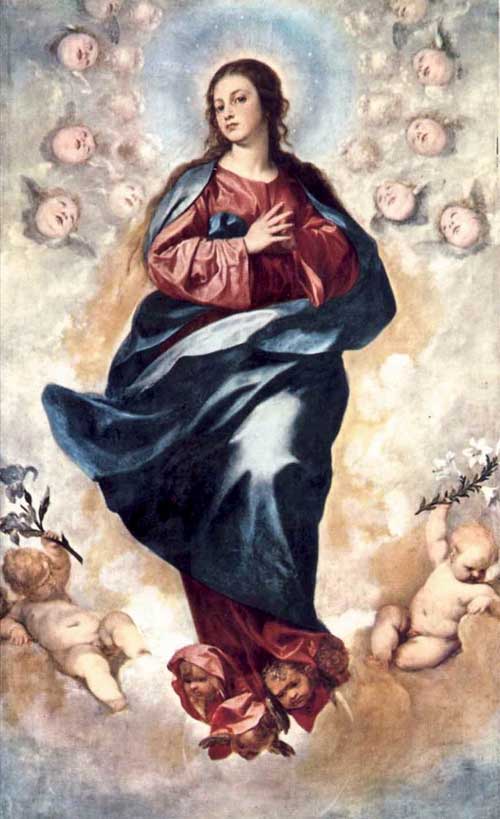
Blessed be the fruit of thy womb.
Blessed are you above all women
for delivering to us Christ Jesus.
Pray for the one
who kneels in prayer before you,
Pray for the wrongdoer
…and for the innocent,
Pray for the weak and oppressed,
…and for those in power,
For the wretched, likewise,
show your mercy.
Pray for the one suffering
cruel misfortune,
Pray for the one who bows his head
under injustice and cruel fate.
And for us… pray for us,
pray always…
…and in the hour
of our death.
Pray for us…
Pray for us…
for us.
Ave Maria . . .
…In the hour of our death.
Ave…
Amen.
Tags: ave maria, catholic, catholic podcast, catholic prayer, cathollc spirituality, Christ Jesus, classical music, death, Desdemona Otello, opera, prayer, renee fleming
This entry was posted on Sunday, March 25th, 2012 at 11:42 pm
You can follow any responses to this entry through the RSS 2.0 feed.
The greatest soprano of this generation offering the most beautiful of all prayers.
Tags: catholic, catholic podcast, catholic prayer, cathollc spirituality, classical music, hail mary, prayers
This entry was posted on Sunday, March 25th, 2012 at 11:27 pm
You can follow any responses to this entry through the RSS 2.0 feed.
The Angel of the Lord declared to Mary: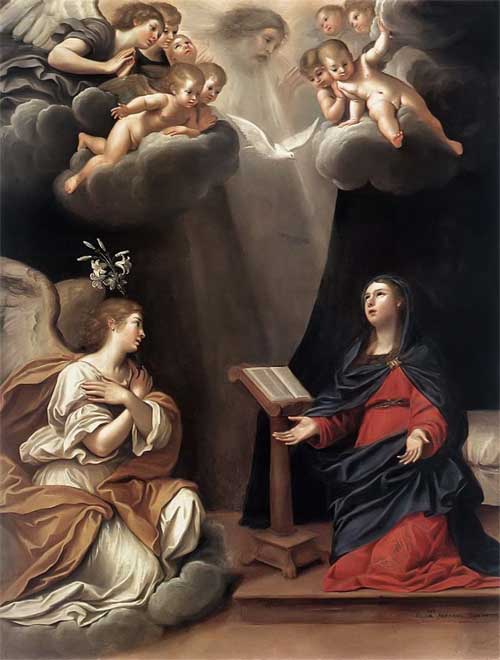
Hail Mary, full of grace, the Lord is with thee; blessed art thou among women and blessed is the fruit of thy womb, Jesus. Holy Mary, Mother of God, pray for us sinners, now and at the hour of
our death. Amen.
Behold the handmaid of the Lord: Be it done unto me according to Thy word.
And the Word was made Flesh: And dwelt among us. Hail Mary . . .
Hail Mary . . .
Pray for us, O Holy Mother of God, that we may be made worthy of the promises of Christ.
Let us pray:
Pour forth, we beseech Thee, O Lord, Thy grace into our hearts; that we, to whom the incarnation of Christ, Thy Son, was made known by the message of an angel, may by His Passion and Cross be brought to the glory of His Resurrection, through the same Christ Our Lord.
Amen.
“Hail, full of grace, the Lord is with you” (Lk 1:28)
“Blessed are you among women,
and blessed is the fruit of your womb”
(Lk 1:42).
Tags: catholic, catholic podcast, catholic prayer, cathollc spirituality, full of grace, hail mary, Holy Mary, mother of god, sacred music, the angelus, Thy Son, women
This entry was posted on Sunday, March 25th, 2012 at 3:52 am
You can follow any responses to this entry through the RSS 2.0 feed.
Vatican City, 14 March 2012 (VIS)– During his general audience this morning the Holy Father began a new cycle ofcatecheses, dedicated to the subject of prayer in the Acts of the Apostles and the Letters of St. Paul. The Pope focused his remarks today on the figure of Mary as she appears in the Acts, when with the Apostles she awaits the coming of the Holy Spirit.Benedict XVI told the more than 10,000 pilgrims gathered in St. Peter’s Square that “it was with Mary that Jesus’ earthly life began, and it was with her that the Church took its first steps. … She discreetly followed her Son’s journey during His public life, even unto the foot of the cross. Then, with silent prayer, she continued to follow the progress of the Church”, he explained.The stages of Mary’s own journey from the house of Nazareth to the Upper Room of Jerusalem “were marked by her capacity to maintain an ongoing state of contemplation, meditating upon each event in the silence of her heart, before God. The Mother of God’s presence with the Eleven after the Ascension … has great significance because with them she shared the most precious of things: the living memory of Jesus in prayer”.After Jesus’ Ascension to heaven, the Apostles met with Mary to await the gift of the Holy Spirit, without which it is not possible to bear witness to Christ. “She, who had already received the Spirit in order to generate the incarnate Word, shared the entire Church’s expectation of the same gift. … If it is true that there could be no Church without Pentecost, it is also true that there could have been no Pentecost without the Mother of Jesus, because she had a unique knowledge of what the Church experiences every day by the action of the Holy Spirit”.
The Pope went on to recall how the Vatican Council II Dogmatic Constitution “Lumen gentium” had emphasised this special relationship between the Virgin and the Church. “We see the Apostles before the day of Pentecost ‘constantly devoting themselves to prayer, together with certain women including Mary the mother of Jesus'”, he said. “Mary’s place is in the Church, ‘wherefore she is hailed as a pre-eminent and singular member, … and as its type and excellent exemplar in faith and charity’.
“Venerating the Mother of Jesus in the Church means, then, learning from her how to become a community of prayer“, the Holy Father added. “This is one of the essential aspects of the first description of the Christian community given in the Acts of the Apostles”.
Our prayers “are often dictated by difficult situations, by personal problems which cause us to turn to the Lord in search of light, comfort and aid. But Mary invites us to open prayer to other dimensions, to address God not only in moments of need and not only for ourselves, but unanimously, perseveringly, faithfully and with ‘one heart and soul'”.
Benedict XVI also pointed out that Mary “was placed by the Lord at decisive moments of the history of salvation, and she always responded with complete readiness as a result of her profound bond with God matured through assiduous and intense prayer. … Between the Ascension and Pentecost, she was ‘with’ and ‘in’ the Church, in prayer. Mother of God and Mother of the Church, Mary exercises her maternity until the end of history”.
The Pope concluded by saying that “Mary teaches us the need for prayer and shows us how only through a constant, intimate and complete bond of love with her Son can we courageously leave our homes … to announce the Lord Jesus, Saviour of the world”.
Tags: blessed virgin mary, catholic, catholic podcast, catholic prayer, cathollc spirituality, pope benedict xvi
This entry was posted on Wednesday, March 14th, 2012 at 4:14 pm
You can follow any responses to this entry through the RSS 2.0 feed.
Vatican City, 7 March 2012 (VIS) – During his general audience this morning Benedict XVI concluded a series of catecheses dedicated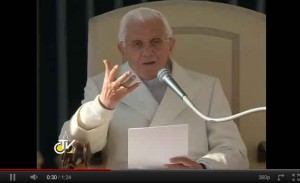 to the prayer of Jesus. Today he turned his attention to the theme of alternating words and silence which characterised Christ’s earthly life, above all on the Cross, and which is also significant in two aspects of our own lives.
to the prayer of Jesus. Today he turned his attention to the theme of alternating words and silence which characterised Christ’s earthly life, above all on the Cross, and which is also significant in two aspects of our own lives.
“This principle”, the Holy Father went on, “holds true for individual prayer, but also for our liturgies which, to facilitate authentic listening, must also be rich in moments of silence and of non verbal acceptance. … Silence has the capacity to open a space in our inner being, a space in which God can dwell, which can ensure that His Word remains within us, and that love for Him is rooted in our minds and hearts, and animates our lives”.
 The Pope then turned to focus on the second important aspect of the relationship between silence and prayer. “In our prayers”, he said, “we often find ourselves facing the silence of God. We almost experience a sense of abandonment; it seems that God does not listen and does not respond. But this silence, as happened to Jesus, does not signify absence. Christians know that the Lord is present and listens, even in moments of darkness and pain, of rejection and solitude. Jesus assures His disciples and each one of us that God is well aware of our needs at every moment of our lives”.
The Pope then turned to focus on the second important aspect of the relationship between silence and prayer. “In our prayers”, he said, “we often find ourselves facing the silence of God. We almost experience a sense of abandonment; it seems that God does not listen and does not respond. But this silence, as happened to Jesus, does not signify absence. Christians know that the Lord is present and listens, even in moments of darkness and pain, of rejection and solitude. Jesus assures His disciples and each one of us that God is well aware of our needs at every moment of our lives”.
“For us, who are so frequently concerned with operational effectiveness and with the results … we achieve, the prayer of Jesus is a reminder that we need to stop, to experience moments of intimacy with God, ‘detaching ourselves’ from the turmoil of daily life in order to listen, to return to the ‘root’ which nourishes and sustains our existence. One of the most beautiful moments of Jesus’ prayer is when, faced with the sickness, discomfort and limitations of his interlocutors, He addresses His Father in prayer, thus showing those around him where they must go to seek the source of hope and salvation”.
Christ touches the most profound point of His prayer to the Father at the moment of His passion and death, Pope Benedict said. And citing the Catechism of the Catholic Church he concluded by noting that “His cry to the Father from the cross encapsulated ‘all the troubles, for all time, of humanity enslaved by sin and death, all the petitions and intercessions of salvation history are summed up in this cry of the incarnate Word. Here the Father accepts them and, beyond all hope, answers them by raising His Son. Thus is fulfilled and brought to completion the drama of prayer in the economy of creation and salvation'”.
Tags: catholic, catholic podcast, catholic prayer, cathollc spirituality, pope benedict xvi
This entry was posted on Wednesday, March 7th, 2012 at 6:01 pm
You can follow any responses to this entry through the RSS 2.0 feed.
Take a listen:Â Â [powerpress]
The Fr. Flanagan Program show 1 of the award winning series produced by T. Scott Marr
The Archdiocese of Omaha will soon begin the process of determining whether Father Edward Flanagan should be declared a saint. Father Flanagan, the Boys Town founder who died in 1948, dedicated much of his life ministering to orphans and troubled youth.
At the request of the Father Flanagan League Society of Devotion (FFLSD), Archbishop George Lucas has accepted responsibility for the beatification process.
“For years many in the Omaha community and beyond have venerated the memory of Father Edward Flanagan,†Lucas said. “I am happy that we can begin the process of examining the holiness that was apparent in his life and
ministry, to see if he might be canonized.â€
Before the cause can officially open, a public notice must be placed on the
doors of St. Cecilia Cathedral for a period of two weeks. This notice alerts the general public that the cause will be opened for Father Flanagan, and it invites the public to share their thoughts with the tribunal in charge of the cause. Archbishop Lucas will place the notice on the Cathedral doors February 27 at 10:00 a.m.
The archdiocese will mark the formal opening March 17 9:00 a.m. with a
prayer service at Immaculate Conception Church (Boys Town), with Archbishop Lucas, Father Steve Boes, national executive director of Boys Town, and other Catholic dignitaries participating. At the prayer service, Father Flanagan will be officially named a “Servant of God.â€
Taken from the Boystown Website:
“Father Edward J. Flanagan is the founder and visionary for what’s known today as Boys Town. He had a dream that every child could be a productive citizen if given love, a home, an education and a trade. He accepted boys of every race, color and creed. Father Flanagan firmly believed, “There are no bad boys. There is only bad environment, bad training, bad example, bad thinking.â€
Father Flanagan was born on July 13, 1886, in County Roscommon, Ireland. In 1904, he set sail for the United States. Following his ordination in 1912, Father Flanagan was assigned to the Diocese of Omaha. On December 12, 1917, Father Flanagan opened his first Boys’ Home in a run-down Victorian mansion in downtown Omaha. In 1921, the Boys’ Home moved to Overlook Farm, its present location near 139th and West Dodge Road. Father Flanagan and Boys Town became internationally known with the help of the 1938 movie, “Boys Town.†He became an acknowledged expert in the field of child care, and toured the United States discussing his views on juvenile delinquency.”
“There are no bad boys. There is only bad environment, bad training, bad example, bad
thinking.â€
“When parents fail to do their job, when they allow their children to run the streets and keep bad company, when they fail to provide them with good examples in the home, then the parents and not the children are delinquent.â€
“The poor, innocent, unfortunate little children belong to us, and it is our problem to give them every chance to develop into good men and good women.â€
“Without God at the beginning, there can be only confusion at the end.â€
“A true religious training for children is most essential if we are to expect to develop them into good men and good women – worthy citizens of our great country.â€
“No race that does not take care of its young can hope to survive – or deserves to survive.â€
“Our country needs good men and good women who have learned to love God above all things, and their fellow man for the love of God.â€
Tags: Boystown, catholic, catholic podcast, catholic prayer, cathollc spirituality
This entry was posted on Monday, February 27th, 2012 at 12:04 am
You can follow any responses to this entry through the RSS 2.0 feed.
Saint Peter Damian
from Vatican.va
Dear Brothers and Sisters,
During the Catecheses of these Wednesdays I am commenting on several important people in the life of the Church from her origins. Today I would like to reflect on one of the most significant figures of the 11th century, St Peter Damian, a monk, a lover of solitude and at the same time a fearless man of the Church, committed personally to the task of reform, initiated by the Popes of the time. He was born in Ravenna in 1007, into a noble family but in straitened circumstances. He was left an orphan and his childhood was not exempt from hardships and suffering, although his sister Roselinda tried to be a mother to him and his elder brother, Damian, adopted him as his son. For this very reason he was to be called Piero di Damiano, Pier Damiani [Peter of Damian, Peter Damian]. He was educated first at Faenza and then at Parma where, already at the age of 25, we find him involved in teaching. As well as a good grounding in the field of law, he acquired a refined expertise in the art of writing the ars scribendi and, thanks to his knowledge of the great Latin classics, became “one of the most accomplished Latinists of his time, one of the greatest writers of medieval Latin”
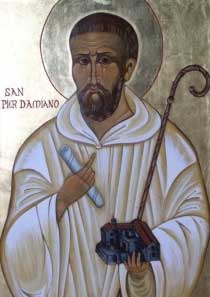 He distinguished himself in the widest range of literary forms: from letters to sermons, from hagiographies to prayers, from poems to epigrams. His sensitivity to beauty led him to poetic contemplation of the world. Peter Damian conceived of the universe as a never-ending “parable” and a sequence of symbols on which to base the interpretation of inner life and divine and supra-natural reality. In this perspective, in about the year 1034, contemplation of the absolute of God impelled him gradually to detach himself from the world and from its transient realties and to withdraw to the Monastery of Fonte Avellana. It had been founded only a few decades earlier but was already celebrated for its austerity. For the monks’ edification he wrote the Life of the Founder, St Romuald of Ravenna, and at the same time strove to deepen their spirituality, expounding on his ideal of eremitic monasticism.
He distinguished himself in the widest range of literary forms: from letters to sermons, from hagiographies to prayers, from poems to epigrams. His sensitivity to beauty led him to poetic contemplation of the world. Peter Damian conceived of the universe as a never-ending “parable” and a sequence of symbols on which to base the interpretation of inner life and divine and supra-natural reality. In this perspective, in about the year 1034, contemplation of the absolute of God impelled him gradually to detach himself from the world and from its transient realties and to withdraw to the Monastery of Fonte Avellana. It had been founded only a few decades earlier but was already celebrated for its austerity. For the monks’ edification he wrote the Life of the Founder, St Romuald of Ravenna, and at the same time strove to deepen their spirituality, expounding on his ideal of eremitic monasticism.
One detail should be immediately emphasized: the Hermitage at Fonte Avellana was dedicated to the Holy Cross and the Cross was the Christian mystery that was to fascinate Peter Damian more than all the others. “Those who do not love the Cross of Christ do not love Christ”, he said (Sermo XVIII, 11, p. 117); and he described himself as “Petrus crucis Christi servorum famulus Peter, servant of the servants of the Cross of Christ” (Ep, 9, 1). Peter Damian addressed the most beautiful prayers to the Cross in which he reveals a vision of this mystery which has cosmic dimensions for it embraces the entire history of salvation: “O Blessed Cross”, he exclaimed, “You are venerated, preached and honoured by the faith of the Patriarchs, the predictions of the Prophets, the senate that judges the Apostles, the victorious army of Martyrs and the throngs of all the Saints” (Sermo XLVII, 14, p. 304). Dear Brothers and Sisters, may the example of St Peter Damian spur us too always to look to the Cross as to the supreme act God’s love for humankind of God, who has given us salvation.
This great monk compiled a Rule for eremitical life in which he heavily stressed the “rigour of the hermit”: in the silence of the cloister the monk is called to spend a life of prayer, by day and by night, with prolonged and strict fasting; he must put into practice generous brotherly charity in ever prompt and willing obedience to the prior. In study and in the daily meditation of Sacred Scripture, Peter Damian discovered the mystical meaning of the word of God, finding in it nourishment for his spiritual life. In this regard he described the hermit’s cell as the “parlour in which God converses with men”. For him, living as a hermit was the peak of Christian existence, “the loftiest of the states of life” because the monk, now free from the bonds of worldly life and of his own self, receives “a dowry from the Holy Spirit and his happy soul is united with its heavenly Spouse” (Ep 18, 17; cf. Ep 28, 43 ff.). This is important for us today too, even though we are not monks: to know how to make silence within us to listen to God’s voice, to seek, as it were, a “parlour” in which God speaks with us: learning the word of God in prayer and in meditation is the path to life.
Tags: catholic, catholic podcast, catholic prayer, cathollc spirituality, doctor of the church, hermit, Peter Damian, Pier Damiani, saint peter damian
This entry was posted on Tuesday, February 21st, 2012 at 12:05 am
You can follow any responses to this entry through the RSS 2.0 feed.
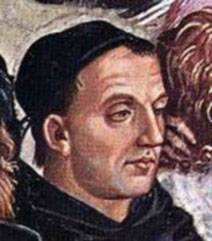 Pope John Paul IIÂ beatified Fra Angelico on October 3, 1982 and in 1984 declared him patron of Catholic artists.
Pope John Paul IIÂ beatified Fra Angelico on October 3, 1982 and in 1984 declared him patron of Catholic artists.
Angelico was reported to say “He who does Christ’s work must stay with Christ always”. This motto earned him the epithet “Blessed Angelico”, because of the perfect integrity of his life and the almost divine beauty of the images he painted, to a superlative extent those of the Blessed Virgin Mary.—Pope John Paul II
Fra Angelico (c. 1395 – February 18, 1455), born Guido di Pietro, was an Early Italian Renaissance painter described by Vasari in his Lives of the Artists as having “a rare and perfect talent”.   He was known to his contemporaries as Fra Giovanni da Fiesole (Brother John from Fiesole) and by Vasari as Fra Giovanni Angelico (Brother John the Angelic One).
Fra Angelico is known in Italy as il Beato Angelico, the term “Il Beato” (“Blessed One”) being already in use during his lifetime or shortly thereafter, in reference to his skills in painting religious subjects. Fiesole is sometimes misinterpreted as being part of his formal name, but it was merely the name of the town where he took his vows as a Dominican friar, and was used by contemporaries to separate him from other Fra Giovannis. He is listed in the Roman Martyrology as Beatus Ioannes Faesulanus, cognomento Angelicus—”Blessed Giovanni of Fiesole, nicknamed Angelico”.
Vasari wrote of Fra Angelico:
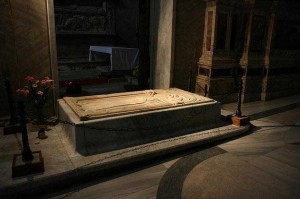
Fra Angelico, Patron Saint of Artists, is buried in the medieval church Santa Maria sopra Minerva, in Rome
But it is impossible to bestow too much praise on this holy father, who was so humble and modest in all that he did and said and whose pictures were painted with such facility and piety.
Tags: catholic, catholic podcast, catholic prayer, cathollc spirituality, sacred art
This entry was posted on Saturday, February 18th, 2012 at 8:37 am
You can follow any responses to this entry through the RSS 2.0 feed.
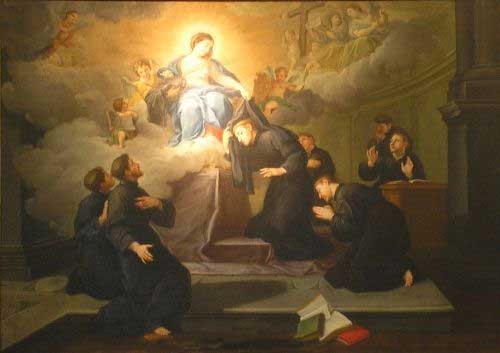
Today is the Church remembers the Seven Founders of the Order of Servites from the 13th Century.
In the mid-13th Century, morals were low and religion seemed nearly meaningless in the political city of Florence. In 1223, seven men from that city decided to form into a small group and go off to a silent place to serve God direct. The Order was founded that day on the Feast of the Assumption as Mary appeared to the seven men. Two of them were widowers and two were still married and brought their families to live together in faith.
They meant to live in solitude, but the group was continually disturbed by visitors. They all left Florence and went to Monte Senario. In 1244, under the direction of St. Peter of Verona, O.P., this group adopted a religious habit similar to the Dominicans and chose to live in accord with the Rule of St. Augustine. They adopted the name of the Servants of Mary.
The men were beatified on December 1, 1717 and canonized in 1887. The original founders were the following:
Saint Alexis Falconieri
Saint Bartholomew degli Amidei
Saint Benedict dell’Antella
Saint Buonfiglio Monaldi
Saint Gherardino Sostegni
Saint Hugh dei Lippi-Uguccioni
Saint John Buonagiunta Monetti
Tags: catholic, catholic podcast, catholic prayer, cathollc spirituality, order of servites, servants of mary, servites
This entry was posted on Friday, February 17th, 2012 at 12:14 am
You can follow any responses to this entry through the RSS 2.0 feed.
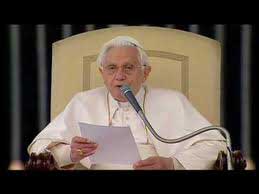 Vatican City, 15 February 2012 Vatican Radio-
Vatican City, 15 February 2012 Vatican Radio-
In his catechesis in Italian, to a packed Paul VI audience hall, the Holy Father said “In our school of prayer last week I spoke about Christ’s prayer on the Cross, taken from Psalm 22 “My God, my God why have you forsaken me”. Now I would like to continue to meditate on the prayers of Jesus on the cross in the imminence of death and today I would like to focus on the narrative that we encounter in the Gospel of St. Luke. The Evangelist has handed down three words of Jesus on the cross, two of which – the first and third – are explicitly prayers to the Father. The second one consists of the promise made to the so-called good thief crucified with him, answering, in fact, the thief’s prayer, Jesus reassures him: “Truly I tell you today will be with me in Paradise” (Lk 23 , 43). The two prayers of the dying Jesus and the acceptance of the repentant sinner’s supplication to Him are suggestively entwined in Luke’s account. Jesus both prays to the Father and hears the prayer of this man who is often called latro poenitens, “the repentant thief.”
Let us dwell on these three prayers of Jesus. The first pronounced immediately after being nailed to the cross, while the soldiers are dividing his garments as sad reward of their service. In a way this gesture closes the process of crucifixion. St. Luke writes: “When they came to the place called the Skull, they crucified him and the criminals there, one on his right, the other on his left. [Then Jesus said, “Father, forgive them, they know not what they do.â€] They divided his garments by casting lots “(23.33 to 34). The first prayer that Jesus addresses to the Father is one of intercession: He asks forgiveness for his executioners. With this, Jesus in person carries out what he had taught in the Sermon on the Mount when he said: ” But to you who hear I say, love your enemies, do good to those who hate you ” (Lk 6:27) and also promised to those who can forgive, “then your reward will be great and you will be children of the Most High ” (v. 35). Now, from the cross, He not only forgives his executioners, but speaks directly to the Father interceding on their behalf.
This is attitude of Jesus’ finds a moving ‘imitation’ in the story of the stoning of St. Stephen, the first martyr. Stephen, in fact, coming to an end, “knelt down and cried with a loud voice:” Lord, do not hold this sin against them”. That said, he died “(Acts 7.60). It was his last word. The comparison of the prayer for forgiveness of Jesus and that of the martyr is significant. Stephen turns to the Risen Lord and calls for his murder – a gesture clearly defined by the expression “this sin” – is not imputed against those who stone him. Jesus addresses the Father on the cross and not only asks for forgiveness for his executioners, but also offers a reading of what is happening. In his words, in fact, the men who crucify him “know not what they do” (Luke 23:34). He gives that ignorance, “not knowing” as the reason for the request for forgiveness from the Father, for this ignorance leaves the way open to conversion, as is the case in the words that the centurion spoke at Jesus’ death: ” This man was innocent beyond doubt”(v. 47), he was the Son of God”. It is a consolation for all times and for all men that the Lord, both for those who really did not know – the killers – and those who knew and condemned him, gives ignorance as the reason for asking for forgiveness – he sees it as a door that can open us up to
repentance “(Jesus of Nazareth, II, 233).
The second prayer of Jesus on the cross as told by St. Luke is a word of hope, is His answer to the prayer of one of the two men crucified with Him. The good thief before Jesus returned to himself and repents, he feels himself to be before the Son of God, who reveals the Face of God, and prays: “Jesus, remember me when you come into your kingdom” (v. 42). The Lord’s answer to this prayer goes far beyond the supplication, he says: ” Amen, I say to you, today you will be with me in Paradise” (v. 43). Jesus is aware of entering directly into communion with the Father and of reopening the path for the man to God’s paradise. So through this response gives the firm hope that the goodness of God can touch us even at the last moment of life and that sincere prayer, even after a life of wrong, meets the open arms of the good Father who awaits the return of his son.
“no matter how hard the trial, difficult the problem, heavy the suffering, we never fall from the hands of Godâ€
Tags: catholic, catholic podcast, catholic prayer, cathollc spirituality, pope benedict xvi, prayer
This entry was posted on Wednesday, February 15th, 2012 at 10:05 pm
You can follow any responses to this entry through the RSS 2.0 feed.
Vatican News Service – CLAUDE LA COLOMBIÈRE, third child of the notary Bertrand La Colombière and Margaret Coindat, was born on 2nd February 1641 at St. Symphorien d’Ozon in the Dauphine, southeastern France. After the family moved to Vienne Claude began his early education there, completing his studies in rhetoric and philosophy in Lyon.
It was during this period that Claude first sensed his vocation to the religious life in the Society of Jesus. We know nothing of the motives which led to this decision. We do know, however, from one of his early notations, that he “had a terrible aversion for the life embraced”. This affirmation is not hard to understand by any who are familiar with the life of Claude, for he was very close to his family and friends and much inclined to the arts and literature and an active social life. On the other hand, he was not a person to be led primarily by his sentiments.
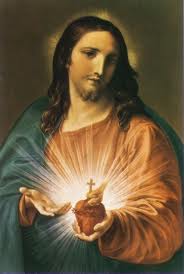 Claude became noted for solid and serious sermons. They were ably directed at specific audiences and, faithful to their inspiration from the gospel, communicated to his listeners serenity and confidence in God. His published sermons produced and still produce significant spiritual fruits. Given the place and the short duration of his ministry, his sermons are surprisingly fresh in comparison with those of better-known orators.
Claude became noted for solid and serious sermons. They were ably directed at specific audiences and, faithful to their inspiration from the gospel, communicated to his listeners serenity and confidence in God. His published sermons produced and still produce significant spiritual fruits. Given the place and the short duration of his ministry, his sermons are surprisingly fresh in comparison with those of better-known orators.
On 2nd February 1675 he pronounced his solemn profession and was named rector of the College at Paray-le-Monial. Not a few people wondered at this assignment of a talented young Jesuit to such an out-of the-way place as Paray. The explanation seems to be in the superiors’ knowledge that there was in Paray an unpretentious religious of the Monastery of the Visitation, Margaret Mary Alacoque, to whom the Lord was revealing the treasures of his Heart, but who was overcome by anguish and uncertainty. She was waiting for the Lord to fulfill his promise and send her “my faithful servant and perfect friend” to help her realize the mission for which he had destined her: that of revealing to the world the unfathomable riches of his love.
After Father Colombière’s arrival and her first conversations with him, Margaret Mary opened her spirit to him and told him of the many communications she believed she had received from the Lord. He 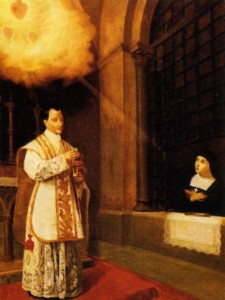 assured her he accepted their authenticity and urged her to put in writing everything in their regard, and did all he could to orient and support her in carrying out the mission received. When, thanks to prayer and discernment, he became convinced that Christ wanted the spread of the devotion to his Heart, it is clear from Claude’s spiritual notes that he pledged himself to this cause without reserve. In these notes it is also clear that, even before he became Margaret Mary’s confessor, Claude’s fidelity to the directives of St. Ignatius in the Exercises had brought him to the contemplation of the Heart of Christ as symbol of his love.
assured her he accepted their authenticity and urged her to put in writing everything in their regard, and did all he could to orient and support her in carrying out the mission received. When, thanks to prayer and discernment, he became convinced that Christ wanted the spread of the devotion to his Heart, it is clear from Claude’s spiritual notes that he pledged himself to this cause without reserve. In these notes it is also clear that, even before he became Margaret Mary’s confessor, Claude’s fidelity to the directives of St. Ignatius in the Exercises had brought him to the contemplation of the Heart of Christ as symbol of his love.
After a year and half in Paray, in 1676 Father La Colombi̬re left for London. He had been appointed preacher to the Duchess of York Рa very difficult and delicate assignment because of the conditions prevailing in England at the time. He took up residence in St. James Palace in October.
In addition to sermons in the palace chapel and unremitting spiritual direction both oral and written, Claude dedicated his time to giving thorough instruction to the many who sought reconciliation with the Church they had abandoned. And even if there were great dangers, he had the consolation of seeing many reconciled to it, so that after a year he said: “I could write a book about the mercy of God I’ve seen Him exercise since I arrived here!”
The intense pace of his work and the poor climate combined to undermine his health, and evidence of a serious pulmonary disease began to appear. Claude, however, made no changes in his work or life style.
Of a sudden, at the end of 1678, he was calumniously accused and arrested in connection with the Titus Oates “papist plot”. After two days he was transferred to the severe King’s Bench Prison where he remained for three weeks in extremely poor conditions until his expulsion from England by royal decree. This suffering further weakened Claude’s health which, with ups and downs, deteriorated rapidly on his return to France.
During the summer of 1681 he returned to Paray, in very poor condition. On 15th February 1682, the first Sunday of Lent, towards evening Claude suffered the severe hemorrhage which ended his life.
On the 16th of June 1929 Pope Pius XI beatified Claude La Colombière, whose charism, according to St. Margaret Mary Alacoque, was that of bringing souls to God along the gospel way of love and mercy which Christ revealed to us.
Tags: catholic, catholic podcast, catholic prayer, cathollc spirituality, margaret mary alacoque, sacred heart of jesus, society of jesus, vatican news service
This entry was posted on Wednesday, February 15th, 2012 at 12:26 am
You can follow any responses to this entry through the RSS 2.0 feed.

